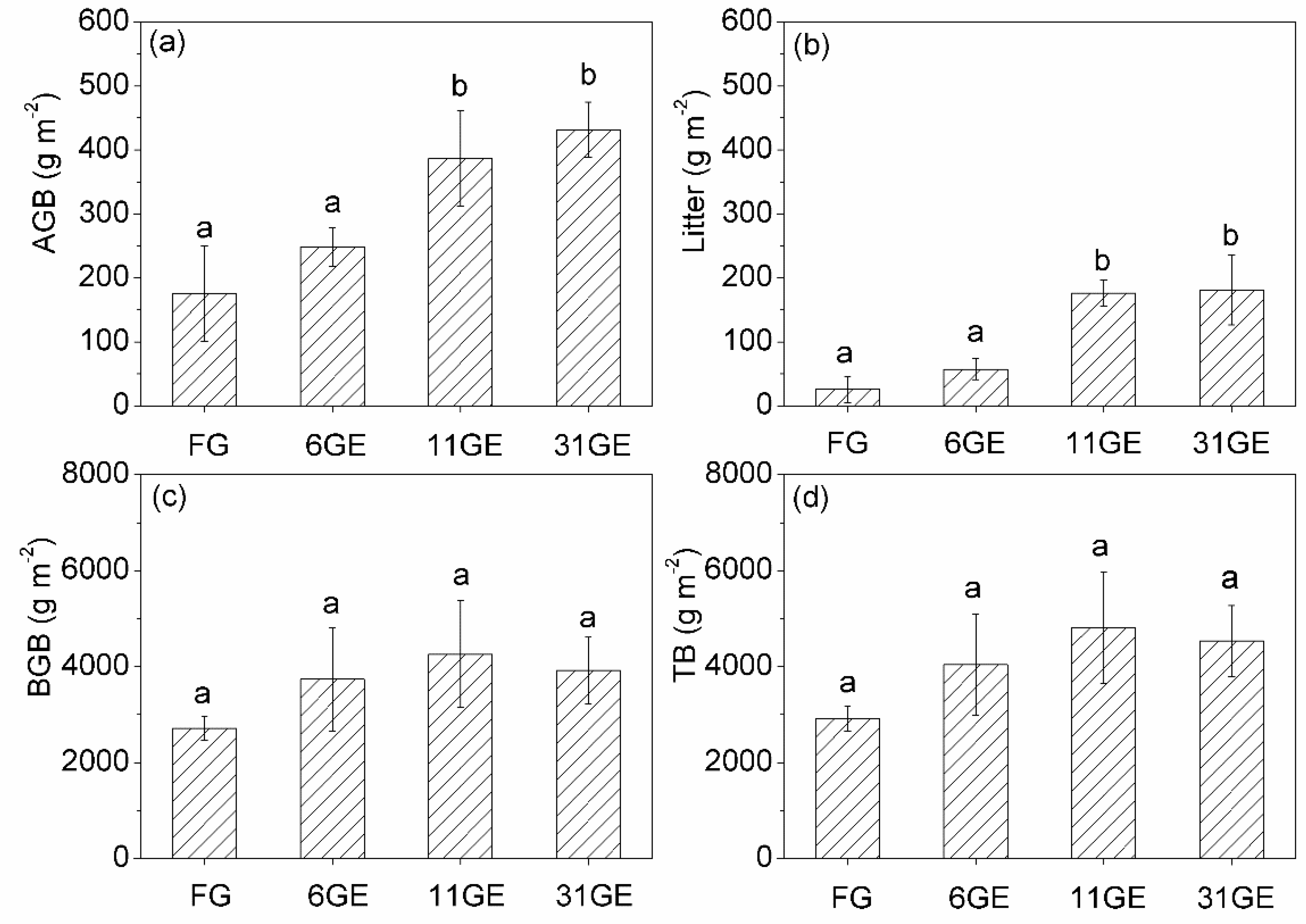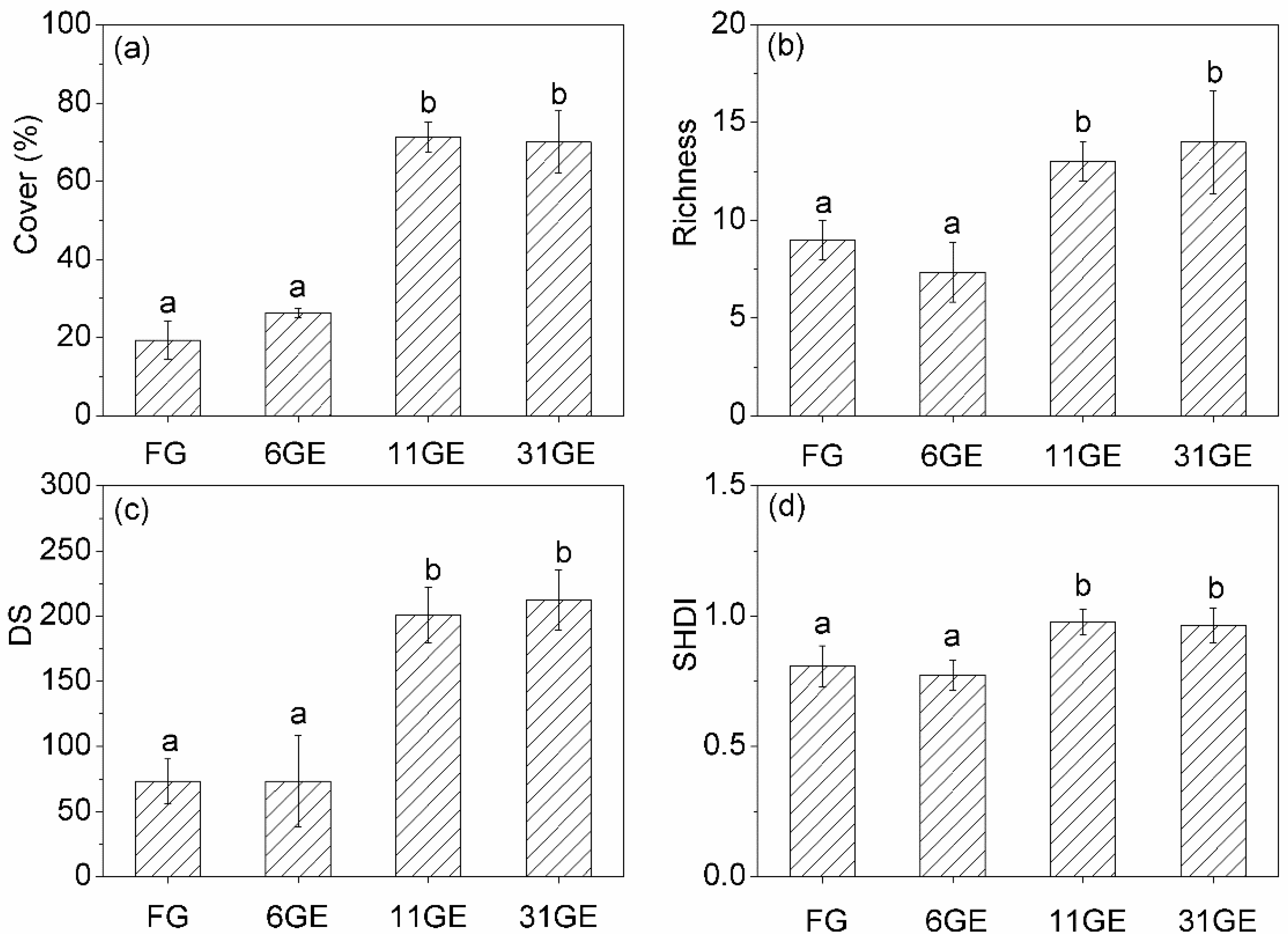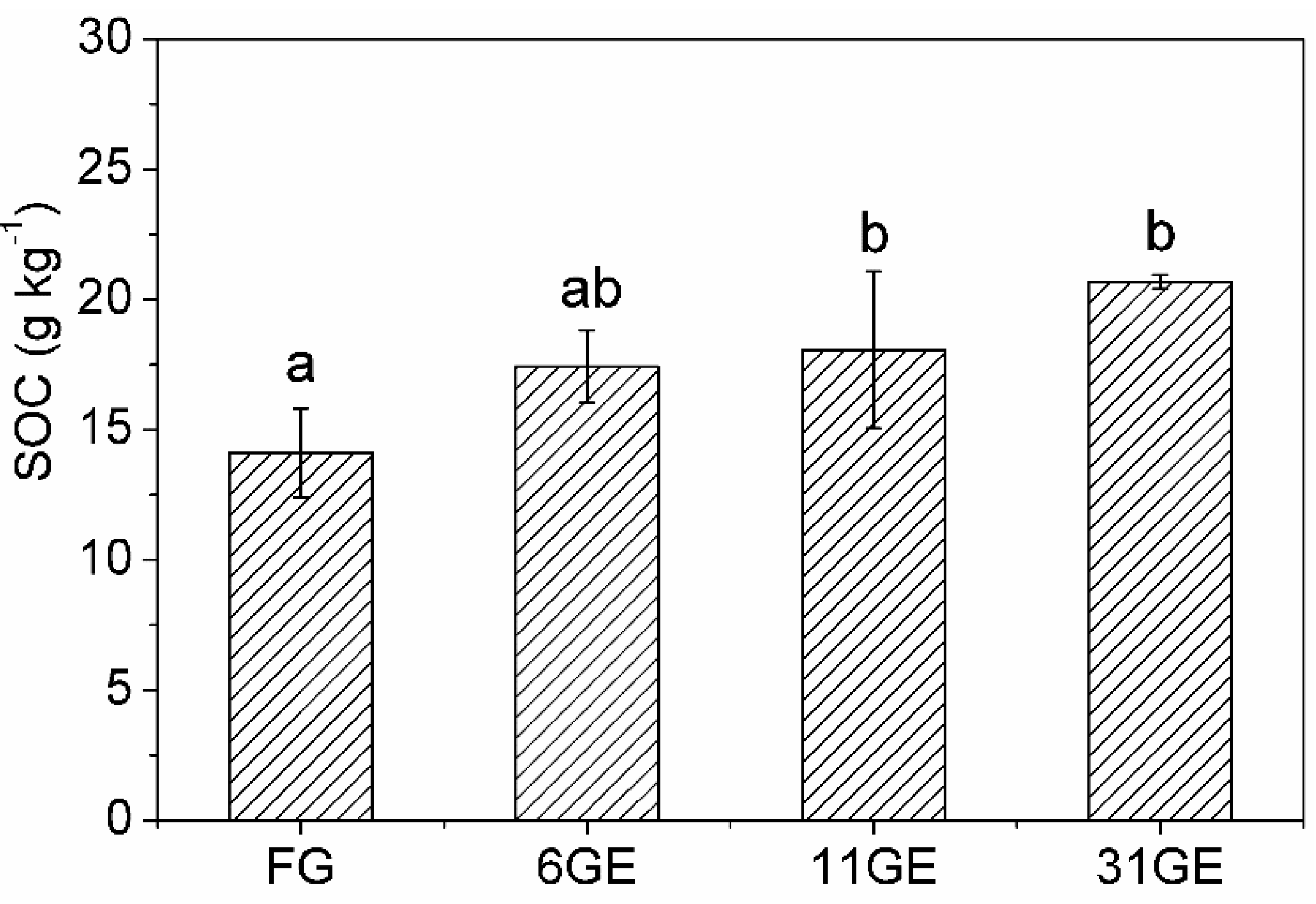Effect of Grazing Exclusion on Vegetation Characteristics and Soil Organic Carbon of Leymus chinensis Grassland in Northern China
Abstract
:1. Introduction
2. Materials and Methods
| Sampling Site | Enclosure Time (Years) | Hight/cm | Dominant Species |
|---|---|---|---|
| FG | 0 | 14.48 ± 11.01 | Leymus chinensis + Stipa grandis |
| 6 GE | 6 | 20.77 ± 11.32 | L. chinensis + S. grandis |
| 11 GE | 11 | 28.48 ± 15.51 | L. chinensis + Carex. tristachya |
| 31 GE | 31 | 30.69 ± 13.34 | L. chinensis + C. tristachya |
2.1. Sampling and Analyses
2.2. Statistical Analysis
3. Results
3.1. Effect of Grazing Exclusion on Vegetation Characteristics


3.2. Effect of Grazing Exclusion on Soil Organic Carbon

3.3. Relationships between Vegetation Characteristics and the SOC
| AGB | Litter | BGB | TB | SOC | Cover | DS | Richness | SHDI | |
|---|---|---|---|---|---|---|---|---|---|
| AGB | 1.000 | ||||||||
| Litter | 0.674 * | 1.000 | |||||||
| BGB | 0.401 | 0.453 | 1.000 | ||||||
| TB | 0.874 ** | 0.946 ** | 0.515 | 1.000 | |||||
| SOC | 0.882 ** | 0.735 ** | 0.545 | 0.871 ** | 1.000 | ||||
| Cover | 0.703 * | 0.895 ** | 0.337 | 0.885 ** | 0.700 * | 1.000 | |||
| DS | 0.672 * | 0.869 ** | 0.176 | 0.846 ** | 0.592 * | 0.961 ** | 1.000 | ||
| Richness | 0.400 | 0.727 ** | 0.170 | 0.641 * | 0.420 | 0.822 ** | 0.812 ** | 1.000 | |
| SHDI | 0.413 | 0.712 * | 0.170 | 0.637 * | 0.361 | 0.843 ** | 0.837 ** | 0.957 ** | 1.000 |
4. Discussion
4.1. Effect of Grazing Exclusion on Vegetation Characteristics and SOC
4.2. Duration of Grazing Exclusion Required for Significant Improvement
4.3. Implications for Grassland Management
5. Conclusions
Acknowledgments
Author Contributions
Conflicts of Interest
Abbreviations
| AGB: | above ground biomass |
| BGB: | below ground biomass |
| DS: | degree of succession |
| SHDI: | Shannon diversity index |
| SOC: | soil organic carbon |
| TB: | total biomass |
References
- Loydi, A.; Zalba, S.M.; Distel, R.A. Vegetation change in response to grazing exclusion in montane grasslands, Argentina. Plant Ecol. Evol. 2012, 145, 313–322. [Google Scholar] [CrossRef]
- Lunt, I.D.; Eldridge, D.J.; Morgan, J.W.; Witt, G.B. A framework to predict the effects of livestock grazing and grazing exclusion on conservation values in natural ecosystems in Australia. Aust. J. Bot. 2007, 55, 401–415. [Google Scholar] [CrossRef]
- Mcsherry, M.E.; Ritchie, M.E. Effects of grazing on grassland soil carbon: A global review. Globl. Chang. Biol. 2013, 19, 1347–1357. [Google Scholar] [CrossRef] [PubMed]
- Akiyama, T.; Kawamura, K. Grassland degradation in China: Methods of monitoring, management and restoration. Grassland Sci. 2007, 53, 1–17. [Google Scholar] [CrossRef]
- Schoenbach, P.; Wan, H.; Gierus, M.; Bai, Y.; Mueller, K.; Lin, L.; Susenbeth, A.; Taube, F. Grassland responses to grazing: Effects of grazing intensity and management system in an Inner Mongolian steppe ecosystem. Plant Soil 2011, 340, 103–115. [Google Scholar] [CrossRef]
- Courtois, D.R.; Perryman, B.L.; Hussein, H.S. Vegetation change after 65 years of grazing and grazing exclusion. J. Range Manag. 2004, 57, 574–582. [Google Scholar] [CrossRef]
- Zhao, Y.; Peth, S.; Krummelbein, J.; Horn, R.; Wang, Z.Y.; Steffens, M.; Hoffmann, C.; Peng, X.H. Spatial variability of soil properties affected by grazing intensity in Inner Mongolia grassland. Ecol. Model. 2007, 205, 241–254. [Google Scholar] [CrossRef]
- Follett, R.F.; Reed, D.A. Soil carbon sequestration in grazing lands: Societal benefits and policy implications. Rangeland Ecol. Manag. 2010, 63, 4–15. [Google Scholar] [CrossRef]
- LenziGrillini, C.R.; Viskanic, P.; Mapesa, M. Effects of 20 years of grazing exclusion in an area of the Queen Elizabeth National Park, Uganda. Afr. J. Ecol. 1996, 34, 333–341. [Google Scholar] [CrossRef]
- Steffens, M.; Kolbl, A.; Totsche, K.U.; Kogel-Knabner, I. Grazing effects on soil chemical and physical properties in a semiarid steppe of Inner Mongolia (PR China). Geoderma 2008, 143, 63–72. [Google Scholar] [CrossRef]
- Zhang, C.; Xue, S.; Liu, G.-B.; Song, Z.-L. A comparison of soil qualities of different revegetation types in the Loess Plateau, China. Plant Soil 2011, 347, 163–178. [Google Scholar] [CrossRef]
- Deleglise, C.; Loucougaray, G.; Alard, D. Effects of grazing exclusion on the spatial variability of subalpine plant communities: A multiscale approach. Basic Appl. Ecol. 2011, 12, 609–619. [Google Scholar] [CrossRef]
- Hoshino, A.; Tamura, K.; Fujimaki, H.; Asano, M.; Ose, K.; Higashi, T. Effects of crop abandonment and grazing exclusion on available soil water and other soil properties in a semi-arid Mongolian grassland. Soil Tillage Res. 2009, 105, 228–235. [Google Scholar] [CrossRef]
- Cheng, J.; Wu, G.L.; Zhao, L.P.; Li, Y.; Li, W.; Cheng, J.M. Cumulative effects of 20-year exclusion of livestock grazing on above- and belowground biomass of typical steppe communities in arid areas of the Loess Plateau, China. Plant Soil Environ. 2011, 57, 40–44. [Google Scholar]
- Tanentzap, A.J.; Coomes, D.A. Carbon storage in terrestrial ecosystems: Do browsing and grazing herbivores matter? Biol. Rev. 2012, 87, 72–94. [Google Scholar] [CrossRef] [PubMed]
- Zhang, Y.; Zhao, W. Vegetation and soil property response of short-time fencing in temperate desert of the Hexi Corridor, northwestern China. Catena 2015, 133, 43–51. [Google Scholar] [CrossRef]
- Rong, Y.; Yuan, F.; Ma, L. Effectiveness of exclosures for restoring soils and vegetation degraded by overgrazing in the Junggar Basin, China. Grassland Sci. 2014, 60, 118–124. [Google Scholar] [CrossRef]
- Kang, L.; Han, X.G.; Zhang, Z.B.; Sun, O.J. Grassland ecosystems in China: Review of current knowledge and research advancement. Philos. Trans. R. Soc. B 2007, 362, 997–1008. [Google Scholar] [CrossRef] [PubMed]
- Bai, Y.; Wu, J.; Clark, C.M.; Naeem, S.; Pan, Q.; Huang, J.; Zhang, L.; Han, X. Tradeoffs and thresholds in the effects of nitrogen addition on biodiversity and ecosystem functioning: Evidence from Inner Mongolia grasslands. Globl. Chang. Biol. 2010, 16, 358–372. [Google Scholar] [CrossRef]
- Pikuła, D.; Rutkowska, A. Effect of leguminous crop and fertilization on soil organic carbon in 30-years field experiment. Plant Soil Environ. 2014, 60, 507–511. [Google Scholar]
- Liang, D.; Fu, B.; Lü, Y.; Liu, Y.; Gao, G.; Li, Y.; Li, Z. Effects of retired steepland afforestation on soil properties: A case study in the Loess Plateau of China. Acta Agric. Scand. B 2012, 62, 547–555. [Google Scholar] [CrossRef]
- Walker, L.R.; Wardle, D.A.; Bardgett, R.D.; Clarkson, B.D. The use of chronosequences in studies of ecological succession and soil development. J. Ecol. 2010, 98, 725–736. [Google Scholar] [CrossRef]
- Simpson, E.H. Measurement of diversity. Nature 1949, 163, 688–688. [Google Scholar] [CrossRef]
- Kitazawa, T.; Ohsawa, M. Patterns of species diversity in rural herbaceous communities under different management regimes, chiba, central japan. Biol. Conserv. 2002, 104, 239–249. [Google Scholar] [CrossRef]
- Bao, S.D. Soil and Agricultural Chemistry Analysis; Agriculture Publication: Beijing, China, 2000; pp. 355–356. [Google Scholar]
- Wang, C.Y.; He, N.P.; Zhang, J.J.; Lv, Y.L.; Wang, L. Long-term grazing exclusion improves the composition and stability of soil organic matter in Inner Mongolian grasslands. PLoS ONE 2015, 10. [Google Scholar] [CrossRef]
- Zhao, L.; Su, J.; Wu, G.; Gillet, F. Long-term effects of grazing exclusion on aboveground and belowground plant species diversity in a steppe of the Loess Plateau, China. Plant Ecol. Evol. 2011, 144, 313–320. [Google Scholar] [CrossRef]
- Wiesmeier, M.; Barthold, F.; Blank, B.; Kogel-Knabner, I. Digital mapping of soil organic matter stocks using random forest modeling in a semi-arid steppe ecosystem. Plant Soil 2011, 340, 7–24. [Google Scholar] [CrossRef]
- Wiesmeier, M.; Kreyling, O.; Steffens, M.; Schoenbach, P.; Wan, H.; Gierus, M.; Taube, F.; Kölbl, A.; Kögel-Knabner, I. Short-Term Degradation of Semiarid Grasslands—Results From a Controlled-Grazing Experiment in Northern China. J. Plant Nutr. Soil Sci. 2012, 175, 434–442. [Google Scholar] [CrossRef]
- Wiesmeier, M. Recovery of Degraded Steppe Soils of Northern China after Grazing Exclusion; Nova Science Publishers: New York, NY, USA, 2013; pp. 221–251. [Google Scholar]
- Kolbl, A.; Steffens, M.; Wiesmeier, M.; Hoffmann, C.; Funk, R.; Krummelbein, J.; Reszkowska, A.; Zhao, Y.; Peth, S.; Horn, R.; et al. Grazing changes topography-controlled topsoil properties and their interaction on different spatial scales in a semi-arid grassland of Inner Mongolia, P.R. China. Plant Soil 2011, 340, 35–58. [Google Scholar]
- Steffens, M.; Kölbl, A.; Kögel-Knabner, I. Alteration of soil organic matter pools and aggregation in semi-arid steppe topsoils as driven by organic matter input. European J. Soil Sci. 2009, 60, 198–212. [Google Scholar] [CrossRef]
- Qiu, L.; Wei, X.; Zhang, X.; Cheng, J. Ecosystem carbon and nitrogen accumulation after grazing exclusion in semiarid grassland. PLoS ONE 2013, 8. [Google Scholar] [CrossRef] [PubMed]
- Wiesmeier, M.; Steffens, M.; Kölbl, A.; Kögel-Knabner, I. Degradation and small-scale spatial homogenization of topsoils in intensively-grazed steppes of northern China. Soil Tillage Res. 2009, 104, 299–310. [Google Scholar] [CrossRef]
- Chen, Y.P.; Li, Y.Q.; Zhao, X.Y.; Awada, T.; Shang, W.; Han, J.J. Effects of grazing exclusion on soil properties and on ecosystem carbon and nitrogen storage in a sandy rangeland of Inner Mongolia, Northern China. Environ. Manag. 2012, 50, 622–632. [Google Scholar] [CrossRef] [PubMed]
- Wiesmeier, M.; Steffens, M.; Mueller, C.W.; Kolbl, A.; Reszkowska, A.; Peth, S.; Horn, R.; Kogel-Knabner, I. Aggregate stability and physical protection of soil organic carbon in semi-arid steppe soils. Eur. J. Soil Sci. 2012, 63, 22–31. [Google Scholar] [CrossRef]
- West, N.E.; Provenza, F.D.; Johnson, P.S.; Owens, M.K. Vegetation change after 13 years of livestock grazing exclusion on sagebrush semidesert in west central Utah. J. Range Manag. 1984, 37, 262–264. [Google Scholar] [CrossRef]
- Lu, X.; Freschet, G.T.; Kazakou, E.; Wang, Z.; Zhou, L.; Han, X. Contrasting responses in leaf nutrient-use strategies of two dominant grass species along a 30-yr temperate steppe grazing exclusion chronosequence. Plant Soil 2015, 387, 69–79. [Google Scholar] [CrossRef]
- Jiao, F.; Wen, Z.-M.; An, S.-S. Changes in soil properties across a chronosequence of vegetation restoration on the Loess Plateau of China. Catena 2011, 86, 110–116. [Google Scholar] [CrossRef]
- Fynn, R.W.S.; O'Connor, T.G. Effect of stocking rate and rainfall on rangeland dynamics and cattle performance in a semi-arid Savanna, South Africa. J. Appl. Ecol. 2000, 37, 491–507. [Google Scholar] [CrossRef]
- Onatibia, G.R.; Aguiar, M.R.; Semmartin, M. Are there any trade-offs between forage provision and the ecosystem service of C and N storage in arid rangelands? Ecol. Eng. 2015, 77, 26–32. [Google Scholar] [CrossRef]
© 2016 by the authors; licensee MDPI, Basel, Switzerland. This article is an open access article distributed under the terms and conditions of the Creative Commons by Attribution (CC-BY) license (http://creativecommons.org/licenses/by/4.0/).
Share and Cite
Chen, J.; Tang, H. Effect of Grazing Exclusion on Vegetation Characteristics and Soil Organic Carbon of Leymus chinensis Grassland in Northern China. Sustainability 2016, 8, 56. https://doi.org/10.3390/su8010056
Chen J, Tang H. Effect of Grazing Exclusion on Vegetation Characteristics and Soil Organic Carbon of Leymus chinensis Grassland in Northern China. Sustainability. 2016; 8(1):56. https://doi.org/10.3390/su8010056
Chicago/Turabian StyleChen, Jiao, and Haiping Tang. 2016. "Effect of Grazing Exclusion on Vegetation Characteristics and Soil Organic Carbon of Leymus chinensis Grassland in Northern China" Sustainability 8, no. 1: 56. https://doi.org/10.3390/su8010056






